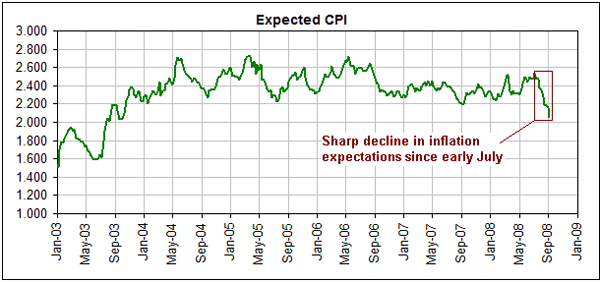The Real Interest Rate
Steve Saville
email: sas888_hk@yahoo.com
Sep 16, 2008
Below is an extract from a commentary originally posted at www.speculative-investor.com on 4th September, 2008.
The real interest rate is the nominal interest rate adjusted to account for the currency's loss of purchasing power. And for lack of a better alternative, most people who do real interest rate calculations assume that changes in the CPI approximate what's happening to the currency's purchasing power. In other words, the real interest rate is typically calculated by subtracting the percentage change in the CPI from the nominal interest rate. For example, the current Fed Funds Rate is 2.0% and the most recent data show that the US CPI gained 5.6% over the past year, so if we make the popular assumption that the real interest rate is the nominal interest rate minus the year-over-year change in the CPI then we will determine that the real Fed Funds rate is presently -3.6% and that the Fed's current policy stance is ultra-easy (if the real Fed Funds rate is negative 3.6% then banks are effectively being paid 3.6% per year to borrow the Fed's money). However, the aforementioned assumption should not be made. Calculating the real interest rate in this way is, in fact, wrong on two important counts.
First, it is wrong because the CPI is a totally meaningless number. It certainly doesn't reflect the "general price level" or changes in the purchasing power of money. Moreover, any attempt to determine the general price level, even the most honest and rigorous attempt, will necessarily fail because the whole concept of an average economy-wide price is nonsensical. You simply can't take an average of totally disparate quantities and reasonably expect to arrive at a meaningful result. And because the CPI -- the official version or any "shadow" version -- is a meaningless number, the result of a calculation involving the CPI must also be a meaningless number.
Second, it is wrong because the real interest rate is the nominal interest rate minus the EXPECTED rate of purchasing power loss. In other words, even if we figured out how to do the impossible and come up with a single number that accurately represented the amount of purchasing power lost by the currency in the past, we still wouldn't know the real interest rate because the real interest rate is determined by how much purchasing power the market expects the currency to lose in the FUTURE.
The bottom line is that it's not possible to calculate the real interest rate and there's no point pretending otherwise. The closest we can get to a valid estimation of the real interest rate is to use, in our calculation, the difference between the yield on a standard Treasury note and the yield on an inflation-protected Treasury note of the same duration to represent the purchasing power loss expected by the market. Note, though, that this is still far from the ideal because the difference between the yields on standard and inflation-protected Treasuries does not reflect the expected change in currency purchasing power, it reflects the expected change in the CPI.
The following chart shows the difference between the yield on a standard 10-year Treasury Note and the yield on a 10-year TIPS (Treasury Inflation-Protected Security). In effect, it shows the rate of CPI change expected by the market.
The "Expected CPI" is presently about 2.0%, which is a far cry from the 5.6% CPI increase reported for the past 12 months. If we make the dubious assumption that the "Expected CPI" is a reasonable approximation of the rate at which the market expects the US$ to lose purchasing power over the next few years then the real Fed Funds rate is currently around zero.

As mentioned above, the CPI change expected by the market and the purchasing power loss expected by the market are two different things. We should therefore be careful about how we use the "Expected CPI". However, while the numerical value of the "Expected CPI" may not match the rate of currency depreciation anticipated by the market, the trend of the "Expected CPI" probably matches reality. For example, during times when the "Expected CPI" is trending lower it will, we think, be reasonable to assume that the market's inflation expectations are falling.
With reference to the above chart, notice that the "Expected CPI" has dropped quite sharply over the past two months and is now at its lowest level since the latter stages of the 2001-2003 deflation scare. This indicates that the market's inflation expectations have recently experienced a significant downward adjustment and, as a consequence, that real interest rates have risen.
Lastly, rather than trying to draw conclusions about the outlooks for currencies, gold, commodities and equities by first 'guesstimating' the real interest rate, it is actually more feasible to draw conclusions about the real interest rate based on how the currency, gold, commodity and equity markets are behaving. For example, the recent pronounced weakness in the gold and commodity markets, combined with a lacklustre stock market and a strong US dollar, suggests that real US interest rates are currently in positive territory.
Steve Saville
 email: sas888_hk@yahoo.com email: sas888_hk@yahoo.com
Hong Kong Regular financial market forecasts and analyses are provided at our web site:
http://www.speculative-investor.com/new/index.html. We aren't offering a free trial subscription at this time, but free samples of our work (excerpts from our regular commentaries) can be viewed at: http://tsi-blog.com
Copyright ©2002-2019 speculative-investor.com All Rights Reserved. Saville Archives
321gold Ltd

|

